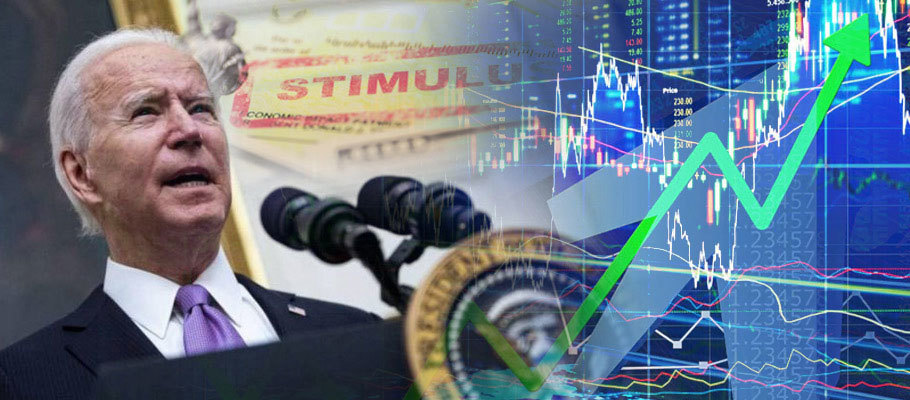
Published: March 15th, 2021
The S&P 500 index inched up by 1% to attain a new record. The growth was a reaction to President Biden's signing of the new stimulus bill to law. The Nasdaq Composite also rallied 2.5% as stocks looked to extend the gains made on Wednesday, March 10.
On Thursday, March 11, U.S. stocks shot to record highs as the comeback of tech shares that began on Wednesday, March 10, continued. Seemingly, the signing of a fresh economic stimulus lent the market sentiment a new boost.
The S&P 500 index jumped by 1% to stand at 3,939.34, recording a new closing high and reclaiming a previous record set on February 16. The Nasdaq Composite gained 2.5% to close the day at 13,398.67. The gains came as the markets witnessed gravitation back into the tech stocks.
Tesla rose by an eye-popping 4.7%, while Apple, Alphabet, Facebook, and Netflix all managed increases of more than 3%. The Dow Jones Industrial Average shot up by 0.6% or 188.57 points to close the trading session at 32,485.59.
The blue-chip benchmark increased by more than 300 points earlier in the session, hitting an intraday high. The impressive gains came after President Joe Biden signed the astonishing $1.9 trillion coronavirus stimulus package into law on Thursday, March 11, in the afternoon.
The legislation will send direct checks of up to $1,400 to eligible Americans. It will also put almost $20 billion into COVID-19 vaccination initiatives. State, local government, and tribal authorities will get about $350 billion.
On Thursday, March 11, a White House statement said that the stimulus checks would reach deserving Americans as early as the weekend of Saturday, March 13.
Scott Ladner, the chief investment officer at Horizon Investments, said the stimulus is hitting the virus, at least in the markets' eyes. The actual rates remaining near negative is historically a strong tailwind for asset prices, he added. Ladner concluded that such trends could not be ignored, especially when everyone is worried about imminent inflation.
Growth and tech stocks are reviving from a swift correction instigated by the rising interest rates. Higher rates make yesteryear profits look less attractive to investors who instead show a preference for stocks with relatively high valuations.
Chip stocks shot up on Thursday, March 11, after China's semiconductor trade association worked out a modality of working with their U.S. counterparts to minimize the trade tensions between the two countries. AMD and Nvidia gained more than 4% each, while Xilinx increased by 6.2%.
The Nasdaq Composite, which had slumped into correction territory on Monday, March 8, dropping more than 10% from its recent high, clawed back more than 5.5%. The 10-year U.S. Treasury yield, which had drawn back from its recent high of 1.62%, did not swing much, closing the day at 1.52%.
Investors were elated by the slightly better-than-expected weekly jobless claims data. The Labor Department's report of first-time filings for unemployment insurance for the week ending March 6 was 712,000, 13,000 less than the Dow Jones estimate.
Mike Loewengart, the managing director of investment strategy at E-Trade Financial, said that the decline in jobless claims is an achievement for the week. Besides, it is a solid indication that the economy is progressing towards pre-pandemic conditions, he added.
Despite the inflation-related fears, the unemployment data paints a very optimistic picture. The ongoing economic reopening coupled with the fiscal stimulus has increased the attraction of stocks in energy and other cyclic sectors. The energy segment of the S&P 500 index has been the best gainer this year, climbing more than 40% since the beginning of 2021.
The Dow's run continued as the week closed. On Friday, March 12, the index climbed by 290 points to ink another record. The increasing optimism around the reopening of the economy is encouraging the gravitation of investment into cyclical stocks.
However, the surging bond yields have revitalized valuation fears and taken off some momentum from the tech stocks. The 30-stock benchmark index rose by almost 1%, or 293.05 points, to stand close to the record high of 32,778.64.
The rising rates gave bank stocks some booster shots in their arms, seeing them off to a new rally. On the other hand, industrials seemed buoyant because of the stimulus, pulling in impressive gains.
Shares of Goldman Sachs rose by 2%, while JPMorgan jumped by 1.2%. Boeing rose by 6.8%, whereas Caterpillar increased by 4.2%. The gains gave the S&P 500 index a boost, getting it out of the lossmaking region, increasing by 0.1%, and closing with a record 3,943.34 points.
Communication services and tech were the only two counters that registered losses. The Nasdaq Composite ended the week about 0.5% lighter. Most of the stocks in the index, which had gained marginally during the previous day's trading session, closed in the red.
Facebook and Alphabet both dropped 2%. Amazon, Apple, and Microsoft also lost some ground. The 10-year U.S. Treasury yield gained ten basis points to settle at 1.64%, a session high and its highest point since February 2020. The benchmark began the year at 0.92%.
The rapid increase in bond yields prompts investors to discard Nasdaq names again after grabbing them just as fast earlier in the week. The market is exhibiting fears that an acute increase in interest rates might impose immense pressures on tech stocks and shave off the proportion of future profits.
According to Ralf Preusser, the rates strategist at Bank of America, higher rates and a less dovish Federal Reserve are the biggest threats to risk assets. He added that passing the stimulus bill and the intense speed of vaccination has eliminated several risks.
The major indexes made marginal gains on Thursday, March 11. Overall, the stock market reported a mixed run, with the tech names dropping slightly because of the market indicators. On the other hand, the banks had a good run because of the interest rates.